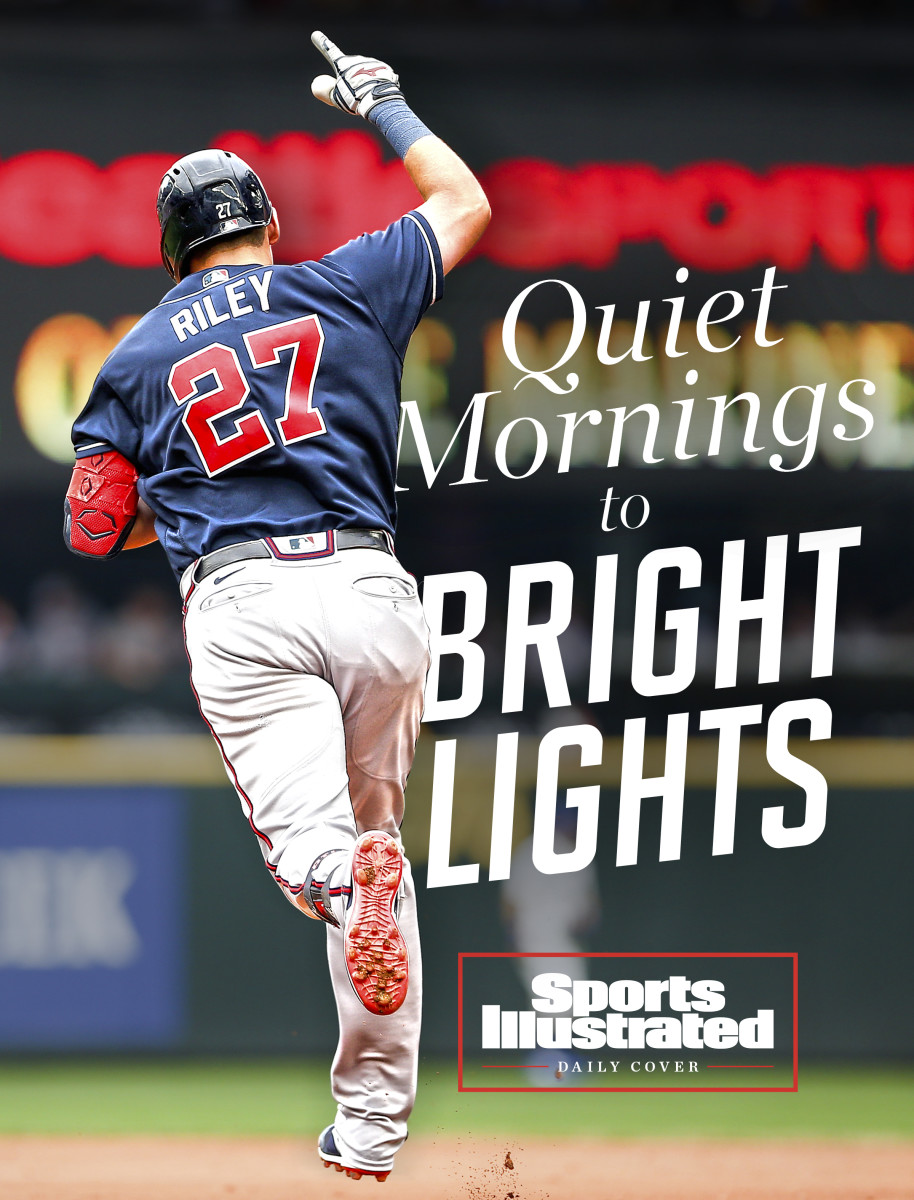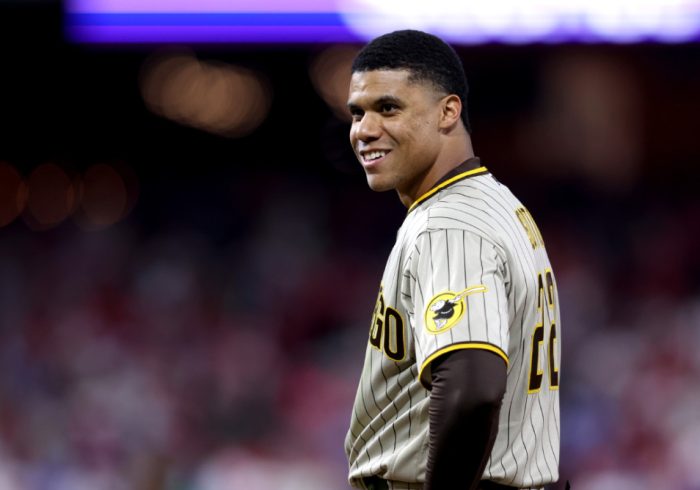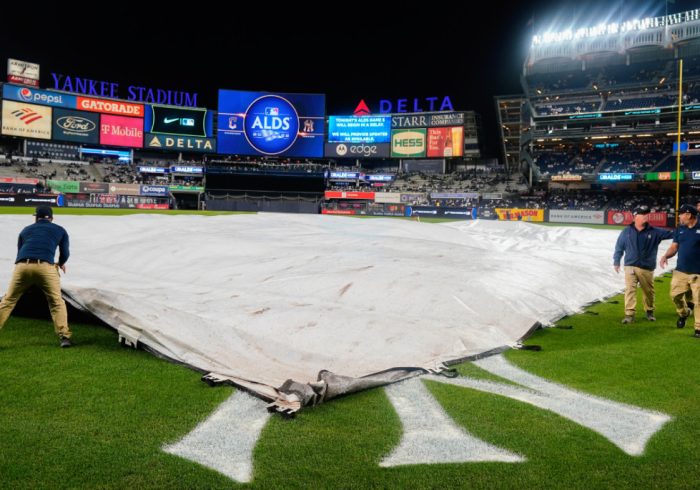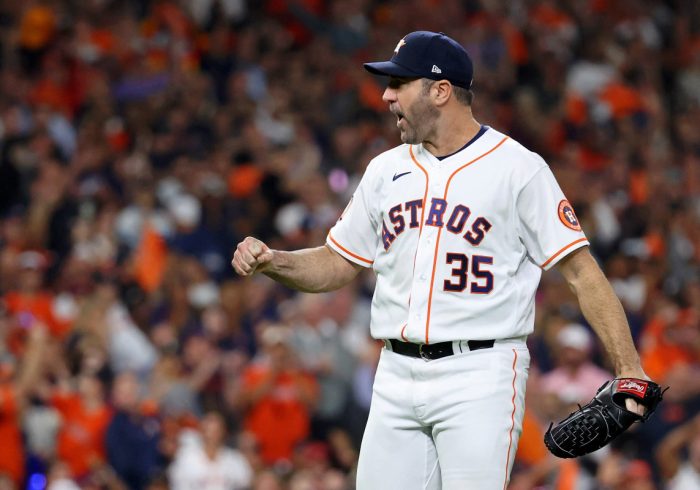Good morning, I’m Dan Gartland. I’m going to be split-screening the Mets and Yankees tonight.
In today’s SI:AM:
🍑 Austin Riley and Atlanta face a huge series
🔄 An eight-player trade in the NBA
If you’re reading this on SI.com, you can sign up to get this free newsletter in your inbox each weekday at SI.com/newsletters.
A playoff appetizer
The NL East could be wrapped up this weekend.
The Mets and Braves begin a three-game series tonight in Atlanta that may very well decide the only division race left unsettled. New York (98–58) holds just a one-game lead over Atlanta (97–59). If the Mets can win all three, they’ll win the division. If the Braves pick up a sweep, they’ll own the tiebreaker by virtue of having the better regular-season record and lead the Mets by two games. Got it? Here’s what to watch for in the series:
How to watch
All three games will be televised nationally. Tonight’s is on MLB Network (in addition to the team’s local stations), tomorrow’s is on Fox and Sunday’s is on ESPN.
The pitching matchups
Today would usually be Chris Bassitt’s turn in the rotation, but manager Buck Showalter is bringing out the big guns. Jacob deGrom is starting tonight against Max Fried in a matchup of both teams’ best pitchers. Because the Mets had an off day Monday, deGrom is not being forced to pitch on short rest. Showalter’s decision also lines up deGrom to pitch on regular rest on the final day of the season if that ends up being a game that the Mets need to win. Max Scherzer gets the ball tomorrow night against Kyle Wright, and Bassitt will pitch Sunday opposite Charlie Morton.
A big-time debut
Speaking of big guns, the Mets are bringing in some serious offensive reinforcements. They’re reportedly calling up Francisco Álvarez, the No. 1 prospect in all of baseball. Álvarez, a 20-year-old catcher, is expected to get some at bats at DH over the final week of the season as he auditions for a spot on the postseason roster.
The Mets have gone with a platoon approach at DH in recent weeks, with left-handed-hitting Daniel Vogelbach getting the nod against righties and righty Mark Vientos facing lefties. Vientos, a rookie ranked by MLB.com as New York’s No. 7 prospect, has struggled since being called up earlier this month. He has just four hits in 12 games.
With the lefty Fried set to start tonight’s game, Álvarez (a righty) figures to replace Vientos in the starting lineup. It’s a big spot for a guy to be making his major league debut, but Álvarez has the reputation to suggest he’ll be just fine. He batted .260 with an .885 OPS in the minors this year, hitting 27 homers in 112 games. But he’s done most of his damage against lefties, hitting .215 with a 1.019 OPS, and ended the season on a hot streak, batting .362 with a 1.079 OPS in 13 games at Triple A in September.
The weather
Earlier in the week when the weather forecast looked worse, the Mets offered to forgo the Thursday off day and get the series started then. But with the remnants of Hurricane Ian expected to remain farther east at this point, it looks like the series should be able to proceed uninterrupted. The forecast doesn’t call for rain at the moment, but it is expected to be quite windy.
What’s next
The good news for both teams is that even if they perform poorly this weekend, they still get to wrap up the season against a beatable opponent. The Mets finish with three games in Queens against the Nationals, while the Braves will travel to Miami for three against the Marlins.
The playoff implications
Both teams have already clinched a playoff spot, but MLB’s new postseason format will really benefit whichever team wins the division. The division winner will be the No. 2 seed in the NL and earn a bye to the NLDS. Whoever wins the wild card will be the No. 4 seed and have home field advantage in a three-game wild-card series against the No. 5 seed, which will probably be the Padres. San Diego has a 2.5-game lead over the Phillies, who are a half game ahead of the Brewers in the race for the final playoff spot.
So who has the advantage?
I’m tempted to say no one. I think the Mets are a marginally better team, but the Braves have the benefit of playing at home. Still, if I had to pick, I’d say the Mets. There haven’t been many teams in history who could trot out two pitchers as intimidating as deGrom and Scherzer in the first two games of the series. Starting pitching is incredibly important in a playoff series—and that’s basically what this is.
The best of Sports Illustrated
For more on the Braves, check out Emma Baccellieri’s Daily Cover on Austin Riley’s emergence:
He broke into the majors with a hot streak in 2019. For a few weeks, his performance matched the best of the reports on him as a prospect: In his first 15 games, Riley was 21-for-59 with seven home runs. But then it started to fall apart. Opposing pitchers figured out that he was extremely vulnerable to anything in the top of the zone, and as he struggled to make that adjustment, other problems spread to the rest of his game. The Braves were using him primarily in the outfield—though he came up as a third baseman, there had been early questions about his ability to stick at the position long term, and the team had been so eager to get his bat in the lineup that it tried him at left field that summer instead—and he was struggling to find his footing there. It felt like nothing was going right. After posting a 1.143 OPS for the month of May, when he first came up, Riley put up a paltry .480 for July. He was briefly sidelined by a knee injury in August. The forced time away felt almost like a disguised blessing.
And, for more on the Mets, Stephanie Apstein looked at how this team is trying to overcome decades of dysfunction in her story from earlier this month. … Terrifying injuries like the one Tua Tagovailoa suffered last night are a reminder of how fraught it can be to love the NFL, Conor Orr writes. … Avi Creditor tried to project the USMNT’s World Cup roster after the final round of friendlies. … Here are our experts’ picks for a loaded week of college football games.
College football’s Week 5 features a huge slate with some intriguing conference matchups. The most sought-after ticket is No. 2 Alabama at No. 17 Arkansas. Games at Clemson, Baylor, Ole Miss and Iowa round out the top 5.
Around the sports world
Former Cowboys tight end Gavin Escobar was killed in a rock climbing incident. … Myles Garrett was given a citation after he crashed his car Monday. … The Thunder and Rockets reportedly pulled off an eight-player trade. … NBA announcer Mike Breen’s Long Island home was destroyed by a fire. … Shohei Ohtani took a no-hitter in the eighth inning last night. … Joel Embiid is officially a U.S. citizen.
SIQ
How did the Washington Senators lose their final home game, on this day in 1971?
- Forfeit
- A walk-off grand slam
- A walk-off balk
- Game called due to rain
Yesterday’s SIQ: Which team won the National League pennant in 1914 after being in last place on July 18?
- Phillies
- Pirates
- Reds
- Braves
Answer: The Braves. Boston was 11 games behind the Giants with a record of 35–43 on July 18, but went 59-16-5 the rest of the way to surge into first place and clinch the pennant with a week still left to play.
Boston had finished the previous season in fifth place, 31.5 games behind the 101-win Giants, so it wasn’t a surprise to see the team languishing at the bottom of the standings around what would be the All-Star break today.
The unlikely pennant race really energized Braves fans. The team’s usual home field was the South End Grounds, which was much smaller than the new ballpark nearby, Fenway. So the Braves moved every September home game to the home of the Red Sox, who were fortunately on a long road trip.
The Braves capped off the season by sweeping the A’s in the World Series for their second championship in franchise history.
From the Vault: Sept. 30, 1968
It’s a reasonably popular position today, but activists in Mexico City in 1968 had what was then a fairly radical idea: hosting the Olympics was not something to celebrate. Protests were just one of the issues facing the Games (construction delays, opposition to apartheid in South Africa, debates about the purity of amateurism), John Underwood wrote in his cover story:
Then there was the question of Mexico’s smoldering young activists. They don’t like President Gustavo Díaz Ordaz’ government, and they are trying to bring it down. As activists they are no different from the young at Berkeley or Columbia. That is to say, some of them are true idealists, and some are what Daniel J. Boorstin has termed the New Barbarians. They are unable to see any long-range good—economic stimulation, national pride—coming from a $150 million Olympic expenditure. There has already been rioting and gunplay in the streets of Mexico City. The rioters are clearly anxious to do their thing in front of plenty of witnesses (the Games will be carried for 42 hours in all on American television and for an average of 11 hours a day on Mexican television). Estimates of what they will do range from demonstrating (waving placards), to genuine acts of sabotage, to the provocation of street warfare.
The talk of protests proved to be tragically prescient. Shortly after Underwood’s story went to print, on Oct. 2, a large group of student protesters gathered in the Plaza de las Tres Culturas in the Tlatelolco section of Mexico City. Police and military opened fire on the crowd, killing an unknown number of demonstrators. (The official report said 26 people were killed, while the protestors estimated there were 190 killed.) It came to be known as the Tlatelolco massacre and effectively stymied the student protest movement that had been active since August. President Ordaz was able to open the Games 10 days later without fear that an international audience would see protests against his government.
Mexico’s ruling party, the PRI, repeatedly squashed attempts to investigate the massacre. It wasn’t until Vicente Fox was elected in 2000—the first president in nearly 70 years who was not a member of the PRI—that a real investigation took place. It found that the Presidential Guard, a branch of the military, stationed snipers on the roofs of buildings in the plaza. The snipers were instructed to fire on the police and military controlling the crowd, documents show, leading the troops to believe they were being fired upon by the students and return fire.
Check out more of SI’s archives and historic images at vault.si.com.
Sports Illustrated may receive compensation for some links to products and services on this website.



